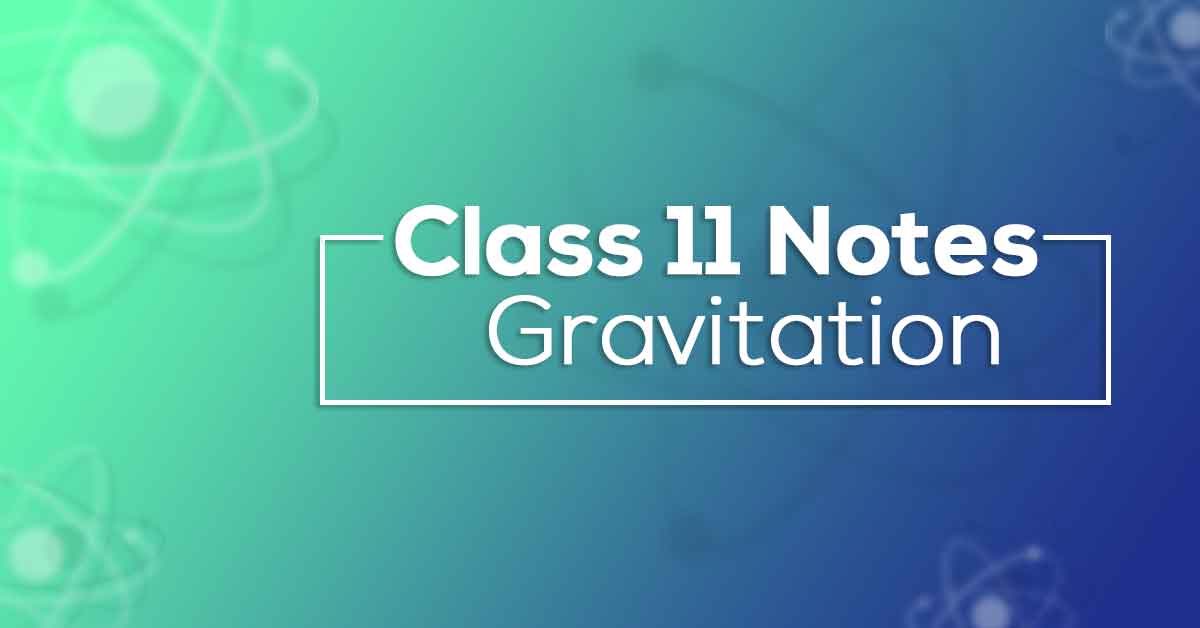Class 11 Physics Chapter 8 Gravitation Notes

Chapter 8 Gravitation Notes
Gravity is one of the important chapters in Physics in Year 11 of the CBSE. Students should study the chapter carefully to get a good grade. In this chapter, students learn about Kepler's laws, the laws of orbits, the gravitational constant, and more. Moreover, these solutions are prepared by top experts according to the recommendations of CBSE.
Students should carefully practice the NCERT notes for Year 11 Physics Chapter 8 to understand the correct way to solve the problem. Vidyakul provides these notes free of charge. In addition to solutions, Vidyakul offers over 300 gravity exercises. This exercise explains the 45 concepts in the chapter. Students should also try mock tests to improve their work. Read on to learn more.
CBSE CLASS 11th PHYSICS CH-8
Points to Remember
Some of the important points to remember from this chapter are as follows:
The gravitational constant experiment was first done by an English scientist Henry Cavendish. Its value is 6.67408 × 10-11 m3 kg-1 s-2.
Value of g on earth (at sea level) = 9.8m/s2.
Acceleration due to Gravity of the Earth: It is the acceleration that an object gains due to the gravitational force. Its unit is m/s2 and is represented by ‘g’.
Escape velocity of an object, ve= √2GM / R =√2gR = √8πp GR2 / 3. Escape velocity at earth is 11.2 km/s.
Binding energy of the satellite mass ‘m’ is given by: B.E = + GMm / 2r.
Gravitational field strength: E = F/M.
Topics and Sub-topics
Students will notice that all objects tend to be attracted to the Earth. When we throw something into the sky, it falls down and lands on the ground. Italian physicist Galileo discovered that all objects fall to the ground with a constant acceleration. In this chapter, students will receive a brief explanation of the same and related concepts.
Important topics in this chapter include Kepler's laws and the law of universal gravitation. Also important topics are escape velocity, gravitational potential energy, and satellites.
Now, let us look at the important topics explained by Vidyakul :
Few Important Questions
What is the ‘Newton’s Law of Gravitation’?
It states that any particle of matter in the universe attracts any other with a force varying directly as the product of the masses and inversely as the square of the distance between them.
What does planetary motion mean?
Three laws devised by Johannes Kepler to define the mechanics of planetary motion.
What is ‘Gravitational constant’?
The universal gravitational constant relates the magnitude of the gravitational attractive force between two bodies to their masses and the distance between them.
Practice Questions
Answer the following :
(a) You can shield a charge from electrical forces by putting it inside a hollow conductor. Can you shield a body from the gravitational influence of nearby matter by putting it inside a hollow sphere or by some other means?
(b) An astronaut inside a small spaceship orbiting around the earth cannot detect gravity. If the space station orbiting around the earth has a large size, can he hope to detect gravity?
(c) If you compare the gravitational force on the earth due to the sun to that due to the moon, you would find that the Sun’s pull is greater than the moon’s pull. (you can check this yourself using the data available in the succeeding exercises).
Suppose there existed a planet that went around the sun twice as fast as the earth. What would be its orbital size as compared to that of the earth? However, the tidal effect of the moon’s pull is greater than the tidal effect of the sun. Why?
Choose the correct alternative:
(a) If the zero of potential energy is at infinity, the total energy of an orbiting satellite is negative of its kinetic/potential energy.
(b) The energy required to launch an orbiting satellite out of earth’s gravitational influence is more/less than the energy required to project a stationary object at the same height (as the satellite) out of earth’s influence.
The gravitational constant experiment was first done by an English scientist Henry Cavendish. Its value is 6.67408 × 10-11 m3 kg-1 s-2.
Value of g on earth (at sea level) = 9.8m/s2.
Acceleration due to Gravity of the Earth: It is the acceleration that an object gains due to the gravitational force. Its unit is m/s2 and is represented by ‘g’.
Escape velocity of an object, ve= √2GM / R =√2gR = √8πp GR2 / 3. Escape velocity at earth is 11.2 km/s.
Binding energy of the satellite mass ‘m’ is given by: B.E = + GMm / 2r.
Gravitational field strength: E = F/M.
What is the ‘Newton’s Law of Gravitation’?
What does planetary motion mean?
What is ‘Gravitational constant’?
Answer the following :
Suppose there existed a planet that went around the sun twice as fast as the earth. What would be its orbital size as compared to that of the earth? However, the tidal effect of the moon’s pull is greater than the tidal effect of the sun. Why?
Choose the correct alternative:
Know more about the same in Class 11 Physics Chapter 8 Gravitation Notes pdf.
Download this solution for FREE Download this PDF






